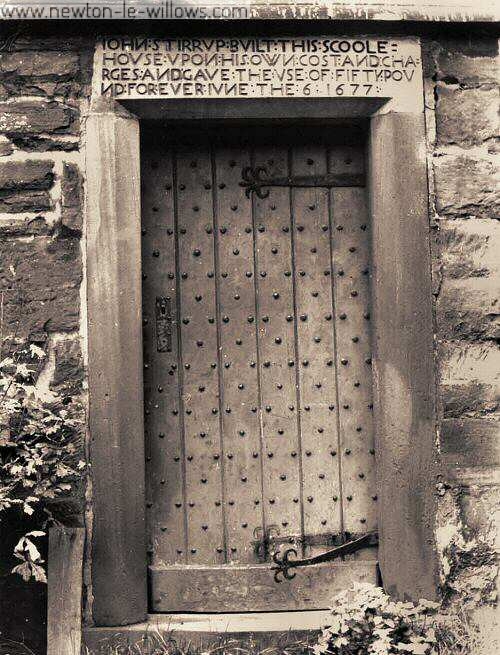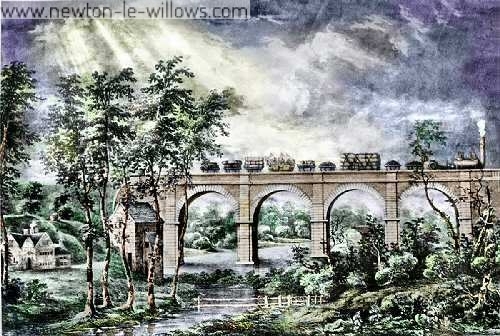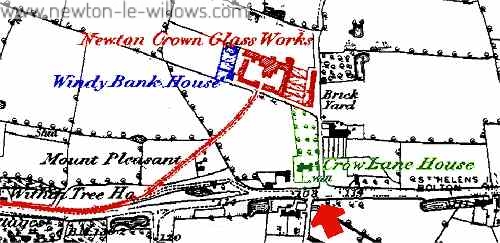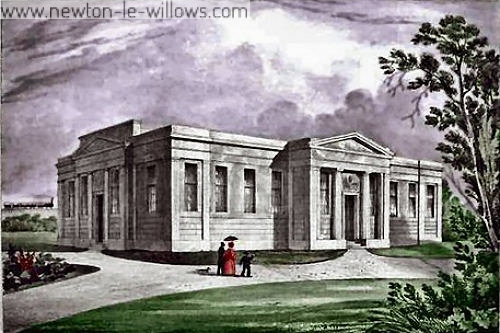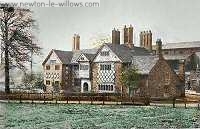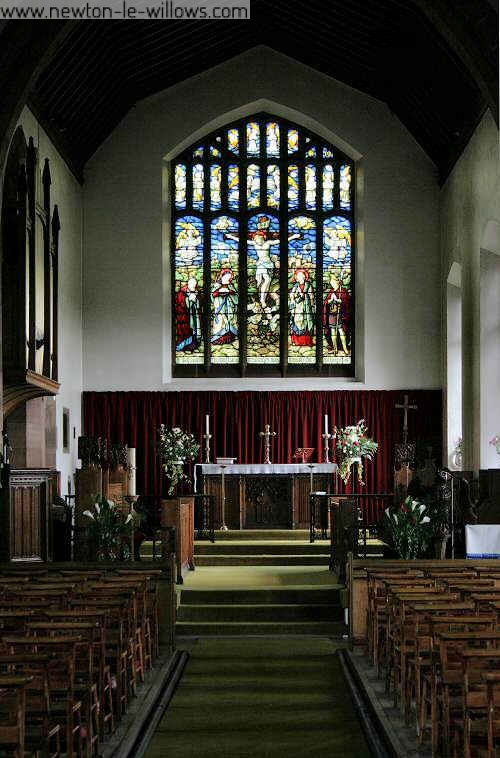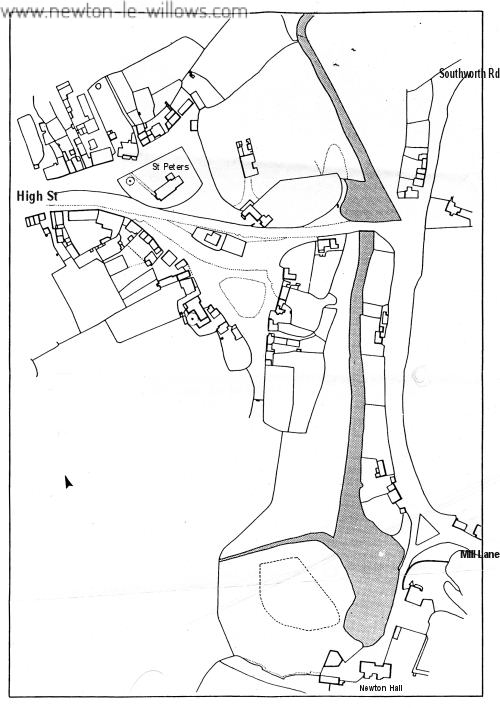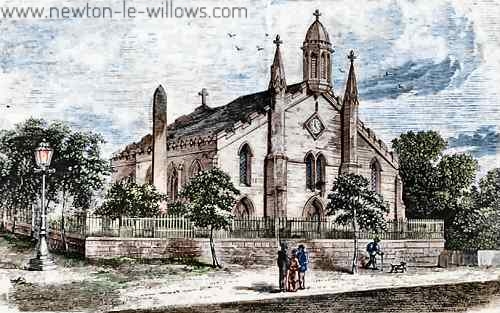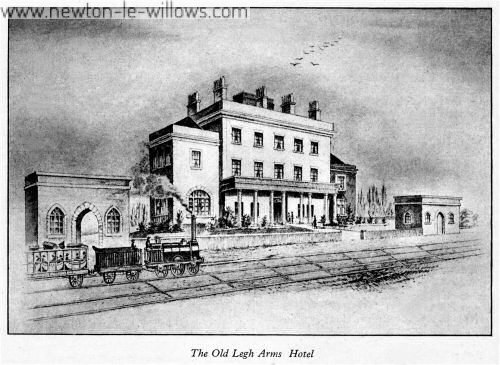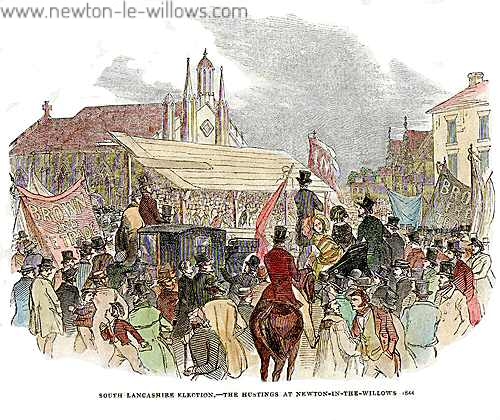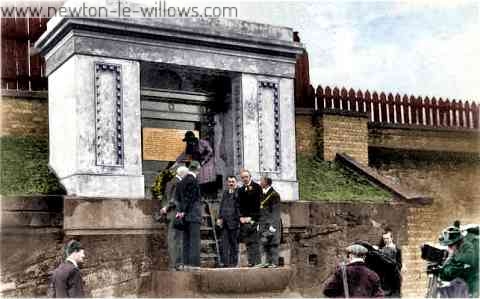Details relating to its early history and later domestic use were discovered during the course of this research. Information about its builder and later residents will also be considered, along with some details about the Dean School Trust set up by the original builder of the property. THE FOUNDATION OF THE SCHOOL Dean School, or Dene School, was founded in 1677 by John Stirrup.(1) The building was erected on a piece of barren land.(2) The date of construction is cited on an inscription that was over the front entrance to…
Read More >>Category: Newton-le-Willows
Newton-le-Willows
To my heart there is no dearer spot upon earth, Than Newton-le-Willows, the place of my birth! Oh! The world has allurements to tempt us to roam, But it cannot supply the endearments of home. Dear Newton! Ill sing of thy sylvan retreats, Of thy lanes, and thy tree-shaded dwellings and streets, Of thy bridge oer the brook with its vista of bloom– A vision of beauty and store of perfume! I will sing of thy ancient, historical hall Near the old ruined mill with its miniature falls The strangers…
Read More >>Newton Glass Works
This Shows the location of the Glass Works In relation to Crow Lane, The Glass works (red) stands on the site where we know have the Fire Station, Opposite is the Brick Works, Windy Bank House (blue) is still standing, but all of the Glass Works or its Railway line are both long gone. This as far as I can tell is the only image that exists that shows anything of the Glass Works, you can see to the right of this image, in the distance the bottle shaped kilns…
Read More >>South Lancashire Conservative Association
The South Lancashire Conservative Association has scarcely been founded three years, and yet during that short period it has enrolled as members all the talent, wealth, and influence of that portion of the palatinate from whence it takes its name. To perpetuate the society a building for the accommodation of its members has been erected since the last anniversary dinner, which is at once the most prominent object in the town of Newton, and we trust will be a lasting monument of the good old English feeling which raised it.…
Read More >>Newton Hall : Archaeological Excavation
I tried as best I could to get video of Mark Adams giving details of what they had found in their excavation, and some video of Stan & John Boydell explaining the layout and uses of the various buildings; Please remember these clips are not edited at all, i have about 2 hrs of different clips from different days that i managed to visit the site, and I hope that when it’s all put together, I will end up with a little fly on the wall type documentary of the…
Read More >>The Lake – Poem by J H Lane
I. FULL sixty years ago, a pretty vale (Now hidden neath the waters of the lake) Extended, in a winding course, from where The railway arches span the road and brook, To Castle Hill, and thence, diverging, ran Eastwards to Golborne Dale, and westwards joined The little sylvan valley of the Dene. Adown each vale a rippling streamlet flowed, Which, at the hill commingling, journeyed on Twixt flowery banks, and murmured past the spot Where now the strong embankment separates The winding lake and willow-shaded brook, Until it reached the…
Read More >>St Peter’s Mission & All Saints Church, Crow Lane
To the Members of the Church of England dwelling at the Earlestown end of the Parish of St. Peter, Newton-in-Makerfield. DEAR FRIENDS, For your benefit we propose to hold. during the coming Winter and Spring, in the large room of the Mill Residence in Fairclough Street, to be entered from the Mill Yard by a new staircase 1. Divine Service every SUNDAY EVENING at 6-30; and also every THURSDAY EVENING at 8 o’clock, for which Prayer Books and Hymn Books will be supplied. 2. Sunday School every SUNDAY AFTERNOON from…
Read More >>Newton in 1745
At this period the wages of an agricultural labourer were 10d per day without food, and 5d if his master provided him with meals. Carpenters and masons received ls 6d per day. The wants of the people, however, were few, and food was cheap, and a shilling had greater purchasing power than it has in the present day. In the early part of the 18th century the manufacture of woollens and of silk was encouraged, to the detriment of cottons and calicoes, and made rapid strides. Probably about this time…
Read More >>Newton-in-Makerfield : yr 1825-35
NEWTON IN MACKERFIELD. NEWTON IN MACKERFIELD is a small Borough Town and Chapelry in the Parish of Winwick, and in the Hundred of West Derby; 5 miles N. of Warrington, and 7 miles S. of Wigan. This Borough contains 275 houses, occupied by 289 families, consisting of 1643 persons. Of these families 56 are employed chiefly in agriculture, 221 in trade,” manufactures, or handicraft, and the remaining 13 are either engaged in professional pursuits or unemployed. The rental of the lands, messuages, and other buildings in the township, according to…
Read More >>Sites of Interest East of Newton
Sites of Interest to The East on Newton-le-Willows Site number 01 Site name Winwick to Golborne Line NGR SJ 5948 9484 to SJ 5977 9535 Site type Railway Period Post-medieval HER number MHER SJ 5994/16 Designation Sources GMAC 1995; Wardell Armstrong 2001; Ordnance Survey 1893c Description The railway was bnilt in the late nineteenth century to connect the Liverpool and Manchester railway line (Site 02) with the Warrington to Preston route. It first appears on the 1893 Ordnance Survey maps and thereafter on all subsequent Ordnance Survey…
Read More >>McCORQUODALE & CO. LTD. 1846-1937
THE following appeared in a newspaper published in 1846: “The capacious building at Newton, on the north side of the Liverpool and Manchester Railway, known until recently as the “Legh Arms Hotel” is being converted into a general printing office.” A printing office in a village like Newton, however humble in pretension, a year ago would have been considered one of the greatest wonders of the age. Wonders do, however, occasionally appear, and one of the greatest we Know of is the conversion in such a place, of a building…
Read More >>Newton, 1800 & 1834
NEWTON, LANCASHIRE. Newton, commonly called Newton in the Willows, is five miles from Warrington, seven from Wigan, IS from Preston, 45 from Lancaster, and 1SS from London, in the road from Warrington to Wigan. It is an ancient borough by prescription, governed by a steward, bailiff, and burgesses, and returns two members to Parliament. The right of election is supposed to be in the burgesses, though there is no resolution of the House of Commons respecting it. The steward of the lord of the manor and the bailiff are the…
Read More >>Newton M.P. committed to the Tower of London
Its Political Importance During the 274 years from 1558 to 1832, Newton was represented by no fewer than 70 different members, and from 1678 (the year the name “Tories” was given to a political party) it was represented exclusively by 30 Tories. In this list of members are found the names of the lords of the manor?the Langtons, the Fleetwoods, and the Leghs?and many gentlemen of rank and importance in the country. It was represented for six years (1695 to 1701) by Thomas Brotherton, Esq., of Old Hey Farm, situated…
Read More >>William Huskisson (1770 – 1830)
This is the Monument that was placed beside the track, at the location of the accident, this photo is from the 1930 Centenary Memorial service The Inscription on the Monument reads : A mark of personal respect and affection has been placed here to mark the spot where, on the 15th of September 1830 at the opening of the railroad THE RIGHT HON. WILLIAM HUSKISSON M.P. singled out by an inscrutable Providence from the midst of the midst of the distinguished multitude that surrounded him, in the full pride of…
Read More >>Newton-le-Willows Official Guide
click the image to open up a new window with the copy of the 1960s map from the guide The East Lancashire Liverpool to Manchester road passes within a few hundred yards of the northern boundary of the Urban District (four main roads communicating between Newton-le-Willows and this, important arterial road) and the Warrington to Wigan trunk road, leading on to Preston and the North, passes through it. Newton-le-Willows is six and a quarter miles from Warrington, eight miles from Wigan and four and a half miles from St. Helens.…
Read More >>